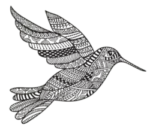(Or: How to Map the World with a Brain Smaller Than a Pea)
In the realm of cognitive abilities, hummingbirds defy every assumption about brain size and intelligence. These remarkable creatures, with brains smaller than a grain of rice, demonstrate memory and navigation capabilities that would impress even the most sophisticated GPS engineers. They remember thousands of flower locations, track blooming schedules, plan complex migration routes, and navigate with precision that modern technology struggles to match.
The Memory Masters
Consider for a moment what it takes to remember the location, quality, and refill rate of every flower in your neighborhood. Now imagine doing that with thousands of flowers across a vast territory, while also remembering safe routes, predator locations, and optimal feeding times. This is the daily reality of a hummingbird’s memorial capabilities.
Essential memory feats include:
- Recall of thousands of flower locations
- Tracking of nectar refill schedules
- Memory of safe flight corridors
A single hummingbird can maintain a mental map of its entire territory, complete with detailed information about each flower’s nectar production schedule. They remember not just where flowers are, but when they’re likely to contain nectar, creating a four-dimensional map that includes both space and time.
The Navigation Network
The sophistication of hummingbird navigation makes modern GPS technology look primitive by comparison. These birds integrate multiple sources of information to maintain precise awareness of their position and destination, all while moving at speeds that would make accurate navigation seem impossible.
They achieve this remarkable feat through a combination of sensory inputs:
- Visual landmarks and patterns
- Magnetic field detection
- Solar position tracking
The precision of their navigation becomes even more impressive when you consider that they’re processing this information while flying at speeds of up to 35 miles per hour, often moving backwards or hovering, and maintaining perfect spatial awareness throughout.
The Migration Marvel
Perhaps nowhere are their memory and navigation skills more impressive than during migration. Many species undertake journeys spanning thousands of miles, following routes they’ve memorized with incredible precision. These tiny travelers cross vast distances without the benefit of maps or satellite guidance, yet manage to find their way with remarkable accuracy.
The complexity of migration requires:
- Long-term memory of routes
- Recognition of temporary refueling stops
- Adaptation to changing weather patterns
What makes this even more remarkable is that young hummingbirds often migrate alone, navigating routes they’ve never traveled before. They somehow combine inherited directional knowledge with real-time navigation skills to reach destinations they’ve never seen.
The Time Keepers
Hummingbirds don’t just remember where things are – they remember when things happen. Their temporal memory allows them to create sophisticated feeding schedules that maximize their energy efficiency.
Their timing abilities include tracking:
- Flower blooming schedules
- Nectar replenishment times
- Territorial competitor patterns
This temporal mapping ability allows them to visit flowers at precisely the right moment when nectar levels are highest, creating efficient feeding routes that minimize energy expenditure while maximizing caloric intake.
The Learning Process
What makes these abilities even more impressive is how quickly hummingbirds can learn and adapt their mental maps. When new flowers appear or old ones disappear, they rapidly update their mental databases, adjusting their feeding routes for maximum efficiency.
Their learning capabilities include:
- Quick adaptation to environment changes
- Rapid assessment of new resources
- Efficient route optimization
Within hours of discovering a new food source, a hummingbird can integrate it into its existing mental map, calculating the most efficient way to include it in its feeding rounds.
The Social Geography
Beyond their physical environment, hummingbirds maintain detailed memories of social landscapes. They remember which territories belong to whom, where boundary disputes commonly occur, and which neighbors might be more tolerant at different times.
This social mapping includes:
- Territory boundaries
- Competitor behaviors
- Safe zones and danger areas
They integrate this social information with their physical maps, creating complex multi-layered mental models of their environment that include both geographical and social dimensions.
The Future Implications
Understanding hummingbird navigation and memory capabilities has profound implications for various fields, from neuroscience to artificial intelligence. Their ability to process complex spatial and temporal information with such a small brain challenges our assumptions about cognitive requirements for sophisticated navigation.
Research applications include:
- Development of more efficient navigation algorithms
- Understanding of memory compression
- Insights into spatial cognition
Conclusion: Nature’s Neural Networks
The memory and navigation capabilities of hummingbirds represent one of nature’s most impressive achievements in cognitive efficiency. These tiny birds demonstrate that sophisticated intelligence doesn’t require large brains. It requires elegant, efficient neural organization.
Remember: When you see a hummingbird precisely navigating its territory, you’re witnessing one of nature’s most sophisticated guidance systems in action, packed into a brain smaller than your fingertip.
Post Script: Some cognitive scientists suspect hummingbirds might possess navigation abilities we haven’t yet discovered. The birds maintain their characteristic focus on reaching their destinations, but their remarkable precision suggests they might know a few things about efficient routing that we’re still trying to figure out.


